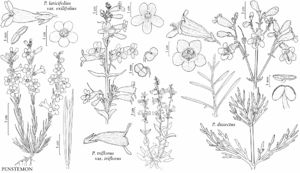Penstemon dissectus
Sketch Bot. S. Carolina 2: 129. 1822.
Stems 32–75 cm. Leaves: cauline 7–11 pairs, 16–50 × 10–28 mm, base tapered to truncate, apex obtuse to acute. Thyrses 6–18 cm, verticillasters 2–4, cymes (1 or)2 or 3(or 4)-flowered; proximal bracts ovate to lanceolate, 4–10 × 3–10 mm; peduncles and pedicels retrorsely hairy. Flowers: calyx lobes ovate to lanceolate, 3–5 × 1.3–2.2 mm; corolla with lavender or violet nectar guides, 20–25 mm, sparsely white-lanate internally abaxially, tube 6–7 mm, throat 8–10 mm diam.; pollen sacs 1.1–1.4 mm; staminode 17–19 mm, distal 2–4 mm sparsely villous, hairs white, to 2 mm; style 14–15 mm. Capsules 7–9 × 4–7 mm.
Phenology: Flowering Apr–May.
Habitat: Open, mixed oak-pine forests, rock outcrops.
Elevation: 10–50 m.
Discussion
Penstemon dissectus is known from approximately 16 counties in the Coastal Plain. The species is unique in Penstemon in having margins of cauline leaves one- or two-pinnatifid. Basal leaves, which usually wither by anthesis, have entire margins.
Selected References
None.
